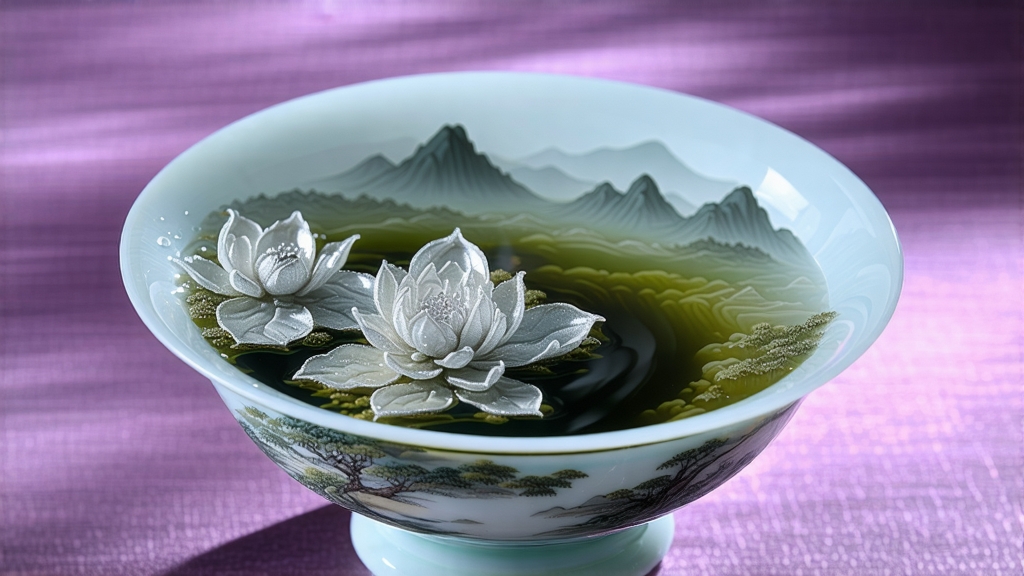
If green tea is the youthful burst of spring and pu-erh the wise elder of the tea world, then Silver Needle—Bai Hao Yin Zhen in Chinese—occupies a realm somewhere between moonlight and silk. Revered as the aristocrat of white teas, it is plucked only for a few fleeting days each early spring, when the air in northern Fujian still carries winter’s chill and the mountain mist lingers like a half-remembered dream. International drinkers often meet white tea first through bagged blends labeled merely “white,” yet to know Silver Needle is to witness how a single cultivar, place, and season can be distilled into a cup of quiet opulence.
1. Historical whispers
The written record of “white tea” reaches back to the Song dynasty (960-1279), when emperor Huizong praised tea buds “covered in silver down” in his Treatise on Tea. Those cakes, however, were steamed and pressed, distant ancestors of today’s loose-leaf style. The modern incarnation of Silver Needle emerged in the late eighteenth century, when improved roadways allowed Fuding and Zhenghe farmers to wither and dry buds naturally rather than compress them. Export merchants in Canton christened the fluffy tips “Silver Needle” because, once dried, they resembled acupuncture needles glinting in the light. By the 1890s the tea traveled to Hong Kong, then to Victorian London, where it fetched prices higher than first-flush Darjeeling. Political turmoil in the mid-twentieth century shrank production to a trickle; only after China’s economic opening in the 1980s did Silver Needle regain its global footing, prized today from Brooklyn cafés to Parisian salons for its understated sweetness and low caffeine bite.
2. Terroir and cultivar
Authentic Silver Needle comes exclusively from Fujian’s two northern counties—Fuding and Zhenghe—each offering a subtle dialect of climate and soil. Fuding, nearer the coast, enjoys marine humidity and red granite soils rich in potassium; the tea grown here tends toward fragrant, lilac-toned aromatics. Zhenghe, slightly inland and higher, possesses cooler nights and deeper loam, coaxing slower growth and a rounder, riper body. The legally protected cultivars are Fuding Da Bai (“Big White”) and Zhenghe Da Bai, whose buds can reach 3.5 cm in length and swell with down so dense it looks like hoarfrost. Attempts to transplant the same cultivars to Yunnan or India yield larger bushes but thinner flavor, proof that Silver Needle is inseparable from its native mist.
3. The craft of “non-craft”
White tea’s minimalism is deceptive; doing almost nothing demands the utmost precision. Picking begins when the bud is still closed and 2.5–3 cm long, ideally before the morning dew evaporates so the cells remain supple. Experienced pluckers use a gentle twist rather than a snap to avoid bruising. The harvest window spans only a handful of days before the bud unfurls into a leaf, making labor costs triple those of conventional teas.
Withering occupies the next 48–72 hours, spread in thin layers on bamboo trays inside sun-lit, breeze-ventilated barns. The goal is to coax moisture out while allowing oxidative enzymes to tick just long enough to soften grassiness—yet halt before true oxidation browns the leaf. Artisans shuffle the buds every hour, monitoring ambient humidity with an instinct calibrated over decades. A sudden rainstorm or a nocturnal temperature dip can spell disaster, so barn roofs slide open and shut like camera apertures. Finally, the tea is baked at temperatures below 60 °C, more desiccation than roast, locking in a moisture content of 5–6 %. The finished buds weigh only one-fifth of their original heft, yet each gram contains roughly 250 individual tips.
4. Grading and varieties
Although all true Silver Needle is bud-only, the market recognizes three unofficial tiers. “Imperial” consists of the first three days of picking, when buds are fattest and most uniform; “Grade A” mixes the remainder of the first week; “Standard” may include late-season or slightly open buds. Some producers experiment with wood-fired charcoal finishing, imparting a whisper of smoke, while others age the tea in clay jars for five years or more, transforming fresh honey notes into darker dried-fruit and medicinal tones reminiscent of aged Riesling.